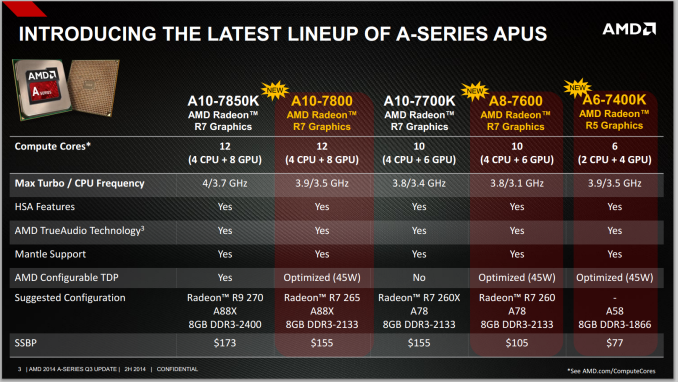AMD A10-7800 Review: Testing the A10 65W Kaveri
by Ian Cutress on July 31, 2014 8:00 AM ESTConclusions
When AMD launched their 95W Kaveri APUs and we had the opportunity to test the top A10 model, it offered some of the best integrated graphics performance for a desktop we had seen. The fact that the die is partitioned such that more than 50% of it is for the graphics, along with expanding HSA and OpenCL support, means that for applications that can be computationally enhanced by integrated graphics, AMD has the edge for the single chip solution.
In our testing, because the A10-7800 shares the same processor graphics configuration and speed as the A10-7850K, results were fairly similar despite a +100 MHz advantage to the A10-7850K. This means that, at stock, AMD is offering a similar CPU for $18 less.
If we remove the price from the equation, the biggest contender for the title of ‘best processor graphics’ is Intel’s Iris Pro. The upside of AMD’s Kaveri at the minute is not only the price, but also the form factor – Iris Pro is only available as a soldered on (BGA) CPU at this point in time whereas Kaveri is in both soldered and socketed form. Also, Iris Pro relies on an extra L4 cache, which adds size to the CPU package as well as cost and power consumption. News from Intel might change that with Broadwell, as back in May an announcement regarding a socketed, overclockable Iris Pro CPU would be coming to market. We have not the slightest clue when AMD will have this competition, but it looks good for AMD given that recent reports suggest that Broadwell for the desktop may be delayed beyond the expected launch of 14nm Core-M in Q1 2015.
In that respect, it may give AMD some time to prepare for their new 64-bit x86 architecture, or give AMD another chance to leap forward in with their Carrizo APUs (still based on modules and GCN) if they are launched in 2015.
Back to the A10-7800 reviewed today, and as it stands it is the most cost effective processor graphics solution available. Here is all the speed of the A10-7850K for $18 cheaper, and more performance than the A8-7600. The 45W configurable TDP makes it even more enticing as a lower power consumption part.
The only issue users might come across is the speed and feel when running single threaded tasks that do not utilise OpenCL or HSA – our web benchmarks put the AMD APUs behind many of our 55W Intel samples for the last couple of generations. But for anything that uses OpenCL as an accelerant, such as the software on which PCMark8 is based or anything compute, AMD comes out on top.











147 Comments
View All Comments
Cerb - Sunday, August 3, 2014 - link
Graphics, and monitor compatibility, up until Haswell. With Haswell, graphics performance (drawing, photo, video, CAD, etc.). Ivy Bridge's IGP, FI, couldn't keep the res right on my Dell 1080p monitors at work. This is 2014, and I still need a video card just for that? I can't speak to IB, but through SB AutoCAD's graphics would be glitchy with Intel's IGP (parts of a viewport not refreshed, or offset from where it should be), as another example. Haswell seems to have gotten rid of those problems.TiGr1982 - Sunday, August 3, 2014 - link
Core i7-3770K has HD 4000, not HD 3000 (Core i7-2600K/2700K had HD 3000).Wixman666 - Thursday, July 31, 2014 - link
REAL budget gaming machine? $45 socket 1150 motherboard, $75 Haswell Pentium G3420 dual core CPU, $120 Nvidia 750 Ti... $240 total. Good on CPU, and graphics runs circles around those both for the same price out of the gate. Forget the i5 or A10.tomsworkshop - Thursday, July 31, 2014 - link
Pentium G3420 - 53W TDPGeforce 750 Ti - 60W TDP
Total - 113W TDP
Form Factor - Full ATX / MicroATX
Pros - better CPU single threaded performance
Cons - higher TDP (more power consumption), higher noise level (more fans "CPU + GPU“), more heat, bigger size
A10-7800 - 65W TDP
Total - 65W TDP
Form Factor - MicroATX / Mini-ITX
Pros - lower TDP (less power consumption), lower noise level (less fan needed), lower heat, Small Form Factor, can hybrid crossfire with low profile discrete GPU
Cons - lower CPU single threaded performance
The_Assimilator - Friday, August 1, 2014 - link
Sure, let's totally ignore the fact that the 750Ti will annihilate the APU in gaming. Or that it's entirely possible to get mITX Intel motherboards.tomsworkshop - Friday, August 1, 2014 - link
sure u can find the mini-itx intel motherboard for G3420 + 750 ti, but the high TDP (higher power consumption) still the matter we will care on this days, and the A10-7800 system could fit in the console size thin and slim casing, while the G3420 + 750 Ti system will not.evilsudoer - Friday, August 1, 2014 - link
The calculation for power draw should probably take the idle numbers instead of the max. Or you could weight it to assume the cpu/gpu are idle 50-80% of the time.Someone who games 8 hours a day probably will get a discrete graphics card regardless of power costs.
tomsworkshop - Friday, August 1, 2014 - link
the owner of the cyber cafe with 50-100 units gaming rig will care for the power cost, if the APU with lower power consumption can handle the games in medium setting at least, they will go for it.Andrew Lin - Tuesday, August 5, 2014 - link
sorry, but this is actually a really stupid argument.tomsworkshop - Thursday, August 14, 2014 - link
yeah, i agree your argument are stupid, and why did u still leave this stupid comment here ?